Swing gates are reliable and economical, and the supply of a drive increases their functionality. The passage opens without leaving the car, no effort is needed. Owners of plots and garages assemble and install electric swing gates with their own hands, since the scheme is simple, and manufacturing does not require special skill.
- Features and types of swing gates
- Required materials and tools
- Swing gate automation
- Choice of material for swing gates
- How Automation Works
- The principle of operation of a linear actuator (actuator)
- Stages of self-production of gates with automation
- Installation of supports
- Sash welding
- Drive structure
- Installation and adjustment of the drive
- How to avoid common mistakes
- Operating rules
Features and types of swing gates
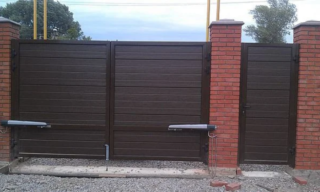
The passage is made only for a car or combined in one structure with a passage for people. The second option is widespread and popular, since the construction of a separate wicket is associated with additional costs. You will need material for the posts, concreting, which is not needed if the passage is made in the door leaf.
Swing doors are made of various materials, mainly they take a steel frame with different filling, insulation. Theoretically, it is possible to make a structure of wood, but in practice, self-opening gates are not made of boards. The stylish option involves forged canvases, which weigh a lot, require the installation of a reinforced electric drive.
Metal frames, frames are welded, sometimes bolted and nut connections are used. The structure is fixed to the walls and pillars with anchors. Fasteners consist of a metal plate with holes for hardware.
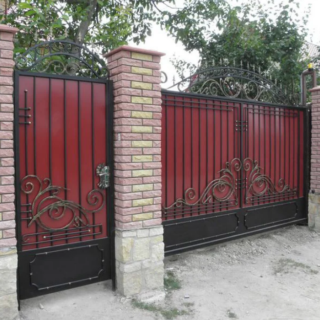
The gate has structural parts:
- pillars;
- gate box;
- awnings;
- frames of canvases or one sash;
- filling the frame;
- automation;
- locking elements.
If the gate is placed together with the supporting pillars, embedded parts are embedded in their thickness. The material is a corner, plates, thick wire. Subsequently, they are welded to the central metal part inside the post (pipe, channel) and taken out to be fixed to the gate frame.
Required materials and tools
Standard gates are made of a profiled pipe 60 x 30 mm and 30 x 20 mm or a corner # 50, 60, 75. Sometimes channel # 40, 50 is used. Colored corrugated board is taken over the area of the shutters so that there are fewer joints. Additional cuts on the canvases are calculated to ensure rigidity. For welding, take electrodes No. 3, 4.
DIY tools for assembling automatic swing gates:
- welding;
- mortar mixer;
- trowel, shovel, faith, stretcher, scrap;
- tape measure 10 m, carpentry square, level, plumb line, core for iron;
- screwdriver, drill;
- hammer, wrenches, pliers.
For painting, you will need brushes and a roller, you can use a spray gun. The paint is stirred in a special cuvette. They use oil, acrylic, latex and enamel compounds, varnish.
Swing gate automation
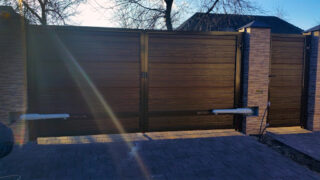
On sale there is a linear type of automation, which is the most common, works by changing the dimensions of the stem. In addition, there are underground and lever varieties.
The linkage device is an elongated stick attached to the motor-reducer at the bottom of the structure. The lever is needed to transmit movement to the gate leaf.It can be easily combined with iron, brick and concrete supports.
An underground mechanism is installed if a large opening solution is needed. This makes the gate construction more expensive, but the sash can be opened by 180 °. The drive hidden in the ground is invisible, since it is mounted below the surface of the earth.
Choice of material for swing gates
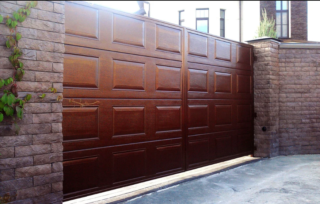
The canvases are collected on a frame, which is sewn up with various materials.
For filling apply:
- insulated sandwich panels;
- professional sheet painted, galvanized, with a pattern for wood, brick, stone;
- transparent and tinted polycarbonate, honeycomb or solid;
- wood, wax-impregnated OSB panels and other materials.
Transparent and lattice fillings are chosen if there is no task to hide the internal space of the site, deaf ones, on the contrary, will not allow views. The material of the gate frame and the sash frame is selected according to the option of the surrounding fence or garage wall.
How Automation Works
The lever-type actuator has two elbows. The rotation begins with the operation of the first element, and when the protrusion of the first handle ends, the second lever begins to move. Power is supplied by means of hollow pipes in which electric wires are stretched; the control unit coordinates the action. The block is mounted on a rack on reinforced embedded parts.
During the absence of the owners, they put locks inside or outside, which are closed while maintaining the automation in an inoperative state, and opened upon returning. Below, under the sashes, stoppers are mounted, which are end stops. Automation stops the turning force after the curtain is abutted against them, since the signal is received that the gate is closed.
The principle of operation of a linear actuator (actuator)
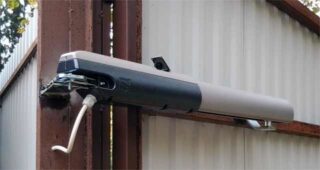
The linear type is mechanically based and hydraulically based. It is installed on iron pillars or columns of small section. The fixed bracket is fixed to the post, and the moving part is located on the sash. Two pairs of photocells control the presence of an object or a person in the opening, block the closing on a remote basis.
A common linear motor works on the principle of a pull-in and protruding rod. The slider moves along the runners using a helical gear. The fastener rotates but imparts a linear direction to the stem.
Linear actuators are distinguished by stroke length, and differ in the dimensions of the translational movement element and the housing. Other characteristics are transmission force and operating speed.
Stages of self-production of gates with automation
Before installation, the axis of the goal line and the places for digging in the supports are broken on the ground. They remove the fertile layer of the earth. The cords are pulled over the stakes so that a quadrangle is obtained at the installation site of the pillars with the door leaves. They control the length of the diagonals, coordinate until they are completely aligned.
The second stage of preparation is digging a trench for the cable, the depth of the pit according to the standards should not be less than 0.9 m. The cable is hidden in a PVC pipe with a cross section of 25 x 30 mm. If it was initially decided to install the gate without automation, such a sleeve is still laid in the ground so as not to break the passageway cover later when installing the automation for swing gates with your own hands.
Installation of supports
Pits for the supports are dug with a garden drill if steel pipes are installed. The size of the pit should be several centimeters larger than the cross-section of the column if only metal is being mounted. When laying a brick over an iron rack, a full-fledged reinforced concrete foundation is made for a brick structure.
The depth of the laying is taken taking into account the standing of the soil moisture and the mark of freezing of the earth. The type of soil is taken into account, since wet clay belongs to the category of heaving and can push out the supports in case of freezing. At the bottom, sand and crushed stone is made, the pillars are concreted only in warm weather without negative temperatures.
Sash welding
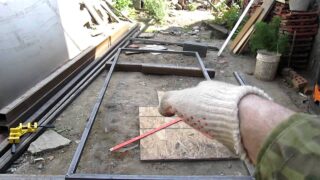
The box is boiled from rolled steel, the massiveness of the structure is set taking into account the weight of the doors, filling, decorative forging and wind resistance. Before assembly, it is appropriate to complete a detailed drawing.
The structure of the box is applied:
- U-shaped ones are used where it is not possible to connect the side parts with a lower girder;
- frames closed around the perimeter.
The first version of the opening gate is inferior in rigidity to the rectangular model. There is a case when the passage cannot be limited from below and from above, then the rigidity of the box frame is completely determined by the bearing capacity of the side elements.
The sash frame is reinforced with diagonals and corner supports. They are welded in order to increase the stability of the web and as a base for the filling installation.
Drive structure
You can make a homemade drive for swing, sliding or lifting sectional structures. To do this, you need a motor, a speed converter (gearbox) and a control mechanism. Traction can be transmitted by a chain and a sprocket or a pressure wheel.
For three-phase voltages, a motor with a star electrical winding is selected to maximize the power of the motor. If there are two phases in the network, then a single-phase unit is used. But at the same time, starting the movement will be difficult due to lack of power.
The drive converter for swing gates is selected taking into account the output torque of revolutions (80 - 100 rpm), while the speed of rotation of the engine must correspond to the input torque of the gearbox.
Installation and adjustment of the drive
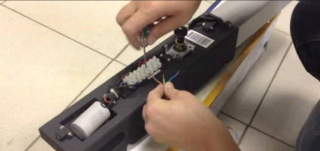
Lever mechanisms are installed for lightweight canvases, but there are also more powerful and expensive models. Linear pulls heavy loads, but in terms of reliability, both devices are the same, so they choose the type for a particular case. The elements of the mechanism are located close to the plane of the gate, insulate from moisture.
The control panel for opening and closing is placed as a separate device in a room or on a street support. The installation of drive parts and spare parts is carried out according to the instructions that accompany the sales kit of the automatic device.
Before setting, unlock the automation with a key to enable manual coordination. Check the smoothness of movement of the canvas so that there are no jolts. If there are difficulties, check the correctness of the installation, as well as the observance of the installation gap, which is recommended by the manufacturer.
How to avoid common mistakes

The work is carried out sequentially so as not to correct installation inaccuracies. The main mistake is that the design of the gate has not been sufficiently checked, the sections of the frame elements have been incorrectly selected. The sash frame is skewed due to insufficient volume of reinforcing elements. Poor digging in of the supports leads to subsidence.
For the stem, 1 cm is left along the way so that it does not rest, which will lead to rapid wear. When setting, a large force is set to increase the opening speed. This is not always a good thing, as the system takes on unnecessary load.
Operating rules
If the door leaf is opened, the wicket must be in the closed position, and there must be no obstacles in the opening. Any malfunctions, noises, sounds make it necessary to stop the drive and clarify the circumstances.
In the case of manual opening, the movement of the flaps is carried out smoothly, without sudden jerks. The remote control is used in the signal area, do not go far. Maintenance and repairs are carried out in a timely manner.








